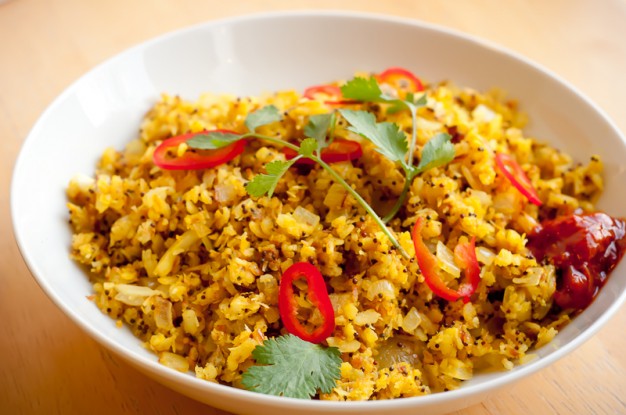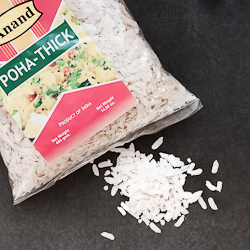Poha (Flattened Rice) with Coconut and Cashews – Recipe

Poha (Flattened Rice) with Coconut and Cashews
 Poha is simply rice that has been flattened. It is a popular food in India, used in a whole range of dishes. In fact, I’d been eating it for years on thalis without really quite realizing what it was. It has become something of a minor obsession for me lately, because it cooks very quickly, produces a light, fluffy texture, and is quite neutral in flavor so it takes to a wide range of treatments.
Poha is simply rice that has been flattened. It is a popular food in India, used in a whole range of dishes. In fact, I’d been eating it for years on thalis without really quite realizing what it was. It has become something of a minor obsession for me lately, because it cooks very quickly, produces a light, fluffy texture, and is quite neutral in flavor so it takes to a wide range of treatments.
Now you aren’t going to find poha at your local supermarket or even Whole Foods. See the small picture at right for an idea of what you are looking for at the Indian grocer, or you can [amazon_link id=”B003BHTZFA” target=”_blank” ]pick it up from Amazon 14oz[/amazon_link] along with some [amazon_link id=”B000JSSOCY” target=”_blank” ]lime pickle 10oz[/amazon_link], which I like to serve with this dish. (Hell, lime pickle would make recycled snow tires taste pretty good.)
You’ll often find at least two thicknesses of poha. I like working with the thick one, as I think it is most forgiving. The main thing you don’t want to do is oversoak or overcook the flakes, as then you will have mush. Be sure to drain them before they fall apart, you just want to get enough liquid in them to rehydrate.
For today’s dish, I’ve added the big flavors of coconut and cashews, together with chilis, spices and sauteed onion. The cashews aren’t in the photo because I love my wife, but trust me, they will be good. If you don’t care for coconut, just leave it out and you’ll still have a delicious dish. Try my version once and then start improvising – I think you’ll find that poha is a fun new friend in the kitchen.
Oh, and before I forget, here’s an easy opportunity for everyone to help with a great cause. I’m a big fan of Elizabeth Andoh’s work. Her book “Kansha” is my go-to reference for basic Japanese flavors. She’s written an ebook called Kibo to raise funds for Japan earthquake relief, one year after the disaster. Just $4 and about 50% vegetarian.
Poha (Flattened Rice) with Coconut and Cashews
Vegetarian, vegan, gluten free and kosher
Serves 2 as a main dish or 4 as a side dish or part of a thali
- 1/2 cup raw cashews
- 6 tablespoons unsweetened dried coconut
- 1 cup thick poha (Indian flattened rice)
- 3 tablespoons vegetable oil
- 3/4 cup cup diced onion
- 1 inch piece of fresh ginger, grated
- 3/4 teaspoon kosher salt
- 1 tablespoon black mustard seed
- 1/2 teaspoon garam masala (or more to taste)
- 1 teaspoon turmeric
- Juice of 1/2 lime
- 1/2 ripe jalapeno (red), thinly sliced
- Cilantro
- Lime pickle
- Toast the cashews in a small, dry skillet over medium low heat until fragrant, about 5 minutes. Reserve. Toast the coconut in the same skillet and reserve.
- Put the poha in a bowl and cover with water. Let sit until fairly tender but not falling apart, about 3 minutes. Drain in a sieve, pressing lightly to remove excess water. Reserve.
- Put the oil in a large skillet, either well-seasoned cast iron or non-stick, over medium-high heat. When the oil is shimmering, add the onion and ginger and fry until the onion begins to soften, about 3 minutes. Add the salt and mustard seeds. When the mustard seeds begin to change color, about 30 seconds, add the garam masala and turmeric. Stir in the drained poha and the coconut. Cook, stirring occasionally and gently for about 3 minutes. Squeeze in the lime juice. Taste and adjust seasoning.
- Serve hot, garnished with cilantro, and offering lime pickle on the side.

How neat! I will have to try this.
I love that you tried this! You can always add cooked potatoes to it as well.
Hey,
Ive been a silent reader of your blog for a while now. It feels so good to know someone who doesnt punish me for being vegetarian, instead helps me celebrate it!.
Poha is one of my absolute favorite breakfast/snack items. Its light, fluffy and flavourful! Also I love to squeeze a little fresh lime juice over my poha. It gives a fresher and better taste than lime pickle.
This looks incredible! I’m definitely going to give it a try.
Hello,
I just wanted to stop by and say how delicious this recipe looks, and say I’m quite thrilled to try it. Additionally I read your ‘why I’m vegetarian, damn it’ and I found it very compelling and thought provoking. I recently began a blog, and I’m vegan, so it’s wonderful to read other people’s perspective.
I look forward to your cookbook.
Healthy Regards,
~RAM~
We also add frozen peas and tiny cubes of boiled potato to the onions once it is light brown. Adds texture and makes a good lunch dish.
Yum! This looks great! Now when you say “lime pickle”, are you referring to salt-preserved limes? Because I have an OBSESSION with salt-preserved citrus. So delicious! I can’t wait to try this recipe… I’m a sucker for coconut and rice dishes with cashews.
Salt-preserved lime is delicious, but Indian lime pickle is something different. Here’s a brand you can often find: http://www.amazon.com/dp/B000JSSOCY/?tag=poeticlicen07-20
I can’t remember the last time that I had a meal with cashews. I think it was at a Tai restaurant. Always like to add an ingredient that will add texture to the meal. I can’t wait to try out this dish. Thanks!
Oh no, you made me go out and buy more fun new ingredients! The Asian grocer I go to from time to time had poha so I snatched some up, but I don’t remember ever seeing it there before. Think I’m going to love your recipe, but I’m also thinking poha could be a great ‘pantry’ staple at work, sort of like couscous. Just rehydrate, add some seasonings, dried fruit and nuts? Instant pilaf when you forgot to bring lunch!
Agreed, yes, it is very neutral and very quick, so I think you could use it that way. Let me know (really) your experiences as you play with it.
My first foray into cooking with Indian spices/foods and I LOVE it! My only problem is that the poha ended up pretty dry for me … should I have left it soaking in the water a bit longer? I still have half of the dish left for dinner tomorrow night … I’m thinking I might throw it into a skillet with some broth to reheat/moisten it a bit. A good idea?
Sounds like it might need just a bit more moisture or less squeezing out, yes. I wouldn’t be surprised if different brands and thicknesses respond slightly differently. I suspect rewarming it with a bit more liquid will be fine. I could actually see the microwave with a couple tablespoons of water in a covered dish working well.
It’s been a while since I’ve visited your site to find something wonderful and vegetarian for our Easter celebration. I was so happy to find this recipe – not for Easter but for tonight’s dinner. I’ll stop by my favorite Indian market today so I can make this for my family right away. Your enfrijoladas de espinaca became a family favorite and I think this one will, too.
Thanks, Kathryn. I saw your note on the nut allergy post as well. Nice to hear from you!
Yum! One of my favorite breakfasts! I usually stick to just onion, peas and maybe potatoes for the veggies. The best thing about poha is that it’s so forgiving–even if you don’t have any vegetables, it’s still delicious! Although, I don’t soak my poha–too much of a chance of it falling apart. Instead, I just put it in a colander and “rinse” it thoroughly. Once in the tawa, I add a little more water and cover it to let it steam.
You know, that makes a ton of sense to me. I saw recipes telling people to soak it even for 30 minutes, and I found that it was plenty moist after just a few, so I don’t really understand that. I’ll try your rinse and steam method too.
Poha is a staple breakfast item for most Indians and there are different versions of it. I love the way Gujaratis make their Poha by adding a little sugar, mustard seeds, very little turmeric and no veggies but I never get it quite right.
So i stick to my version with lots of onion, coriander, tomatoes and potatoes. While tempering, curry leaves and green chillies can also be added if you can handle the heat! And I like to garnish it sometimes with raw onions too.
However I like my Poha very mushy because otherwise it becomes too dry for my taste.
I have to tell you that I make this recipe all the time and I think it’s my absolute favorite meal (I serve it with Dal and Rotis). Thank you 🙂